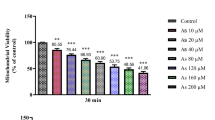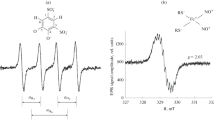Abstract
It is well established that several iron complexes can induce oxidative damage in hepatic mitochondrial membranes by catalyzing the formation of ·OH radicals and/or by promoting lipid peroxidation. This is a relevant process for the molecular basis of iron overload diseases. The present work demonstrates that Fe(II)ATP complexes (5–50μM) promote an oxygen consumption burst in a suspension of isolated rat liver mitochondria (either in the absence or presence of Antimycin A), caused mainly by lipid peroxidation. Fe(II)ATP alone induced small levels of oxygen uptake but no burst. The time course of Fe(II)ATP oxidation to Fe(III)ATP in the extramitochondrial media also reveals a simultaneous ‘burst phase’. The iron chelator Desferal (DFO) or the chain-break antioxidant butylated hydroxytoluene (BHT) fully prevented both lipid peroxidation (quantified as oxygen uptake burst) and mitochondrial swelling. DFO and BHT were capable of stopping the ongoing process of peroxidation at any point of their addition to the mitochondrial suspension. Conversely, DFO and BHT only halted the Fe(II)ATP-induced mitochondrial swelling at the onset of the process. Fe(II)ATP could also cause the collapse of mitochondrial potential, which was protected by BHT if added at the onset of the damaging process. These results, as well as correlation studies between peroxidation and mitochondrial swelling, suggest that a two phase process is occurring during Fe(II)ATP-induced mitochondrial damage: one dependent and another independent of lipid peroxidation. The involvement of lipid peroxidation in the overall process of mitochondrial membrane injury is discussed.
Similar content being viewed by others
Abbreviations
- AA:
-
Antimycin A
- BHT:
-
butylated hydroxytoluene
- EGTA:
-
ethylene glycol-bis(β-aminoethyl ether)
- N,N,N′,N′:
-
tetraacetic acid
- DFO:
-
Desferal
- HEPES:
-
N-(2-hydroxyethyl)piperazine-N′-2-ethanesulfonic acid
- SOD:
-
superoxide dismutase
- TPP+:
-
tetraphenylphosphonium bromide
- TBARS:
-
thiobarbituric acid reactive substances
References
Masini A, Trenti T, Ceccarelli-Stanzani D, Ventura E: The effect of ferric iron complex on isolated rat liver mitochondria. I. Respiratory and electrochemical responses. Biochim Biophys Acta 810: 20–26 1985
Bindoli A: Lipid peroxidation in mitochondria. Free Rad Biol Med 5: 247–261, 1988
Fagian MM, Pereira-da-Silva L, Martins IS, Vercesi AE: Membrane protein thiol cross-linking associated with the permeabilization of the inner mitochondrial membrane by Ca2+ plus prooxidants. J Biol Chem 265: 19955–19960, 1990
Szabo I, Zoratti M: The mitochondrial megachanel is the permeability transition pore. J Bioenerg Biomembr, 24: 111–117, 1992
Vladimirov YA, Olenev VI, Suslova TB, Cheremisina ZP: Lipid peroxidation in mitochondrial membranes. Adv Lipid Res 17: 173–249, 1980
Bacon BR, Britton RS: The pathology of hepatic iron overload: A free radical-mediated process? Hepatology 11: 127–137, 1990
Chevion M, Jiang Y, Har-El R, Berenshtein E, Uretzky G, Kitrossky N: Copper and iron are mobilized following myocardial ischemia: Possible predictive criteria for tissue injury. Proc Natl Acad Sci USA 90: 1102–1106, 1993
Bacon BR, O'Neill R, Park CH: Iron-induced peroxidative injury to isolated rat hepatic mitochondria. Free Rad Biol Med 2: 339–347, 1986
Castilho RF, Meinicke AR, Almeida AM, Hermes-Lima M, Vercesi AE: Oxidative damage of mitochondria induced by Fe(II)citrate is potentiated by Ca2+ and includes lipid peroxidation and alterations in membrane proteins. Arch Biochem Biophys 308: 158–163, 1994
Gunter TE, Pfeiffer DR: Mechanisms by which mitochondria transport calcium. Am J Physiol 258: C755-C786, 1990
Hermes-Lima M, Castilho RF, Valle VGR, Bechara EJH, Vercesi AE: Calcium-dependent mitochondrial oxidative stress promoted by 5-aminolevulic acid. Biochim Biophys Acta 1180: 201–206, 1992
Hunter FE Jr, Gebicki JM, Hoffsten PE, Weinstein J, Scott A: Swelling and lysis of rat liver mitochondria induced by ferrous ions. J Biol Chem 238: 828–835, 1963
McKnight RC, Hunter FE Jr: Mitochondrial membrane ghosts produced by lipid peroxidation induced by ferrous ion. II. Composition and enzymatic activity. J Biol Chem 241: 2757–2765, 1966
Wiswedel I, Trumper L, Schild L, Augustin W: Injury of mitochondrial respiration and membrane potential during iron/ascorbate-induced peroxidation. Biochim Biophys Acta 934: 80–86, 1988
Novgodov SA, Gudz TI, Kushnareva YE, Roginsky VA, Kudrjashov YuB: Mechanism accounting for the induction of nonspecific permeability of the inner mitochondrial membrane by hydroperoxides. Biochim Biophys Acta 1058: 242–248, 1991
Shivaswamy V, Ramakrishna Kurup CK, Ramasarma T: Ferrous-iron induces lipid peroxidation with little damage to energy transduction in mitochondria. Mol Cell Biochem 120: 141–149, 1993
Schneider WC, Hogeboom GH: Intracellular distribution of enzymes. V. Further studies on the distribution of cytocrome C in rat liver homogenates. J Biol Chem 183: 123–128, 1950
Jensen BD, Gunter KK, Gunter TE: The efficiencies of the component steps of oxidative phosphorylation. II. Experimental determination of the efficiencies in mitochondria and examination of the equivalence of membrane potential and pH gradient in phosphorylation. Arch Biochem Biophys 248: 305–323, 1986
Buege JA, Aust SD: Microsomal lipid peroxidation. Methods Enzymol 52: 302–310, 1978
Halliwell B, Gutteridge JMC: Free Radicals in Biology and Medicine, Oxford: Claredon Press, 1989
Miller DM, Buettner GR, Aust SD: Transition metal as catalysts of ‘autoxidation’ reactions. Free Rad Biol Med 8: 95–108, 1990
Ruuge EK, Ledenev AN, Lakomkin VL, Konstantinov AA, Ksenzenko MY: Free Radical metabolites in myocardium during ischemia and reperfusion. Am J Physiol (Suppl, Oct) 261: 81–86, 1991
Brooks SPJ: A simple computer program with statistical tests for the analysis of enzyme kinetics. Bio Techniques 13: 906–911, 1992
Riley WW, Pfeiffer DR: Relationship between Ca2+ release, Ca2+ cycling, and Ca2+-mediated permerability changes in mitochondria. J Biol Chem 260: 12416–12425, 1985
Ursini F, Maiorino M, Hochstein P, Ernest L: Microsomal lipid peroxidation: mechanisms of initiation. The role of iron and iron chelators. Free Rad Biol Med 6: 31–36, 1989
Sassa H, Takaishi Y, Terada H: The triterpene celastrol as a very potent inhibitor of lipid peroxidation in mitochondria. Biochem Biophys Res Commun 172: 890–897, 1990
Minotti G, Aust SD: The requirement for iron(III) in the initiation of lipid peroxidation by iron(II) and hydrogen peroxide. J Biol Chem 262: 1098–1104, 1987
Halliwell B, Gutteridge JMC: Role of free radicals and catalytic metal ions in human disease: an overview. Methods Enzymol 186: 1–85, 1990
Yoshida Y, Furuta S, Niki E: Effects of metal chelating agents on the oxidation of lipids induced by copper and iron. Biochim Biophys Acta 1210: 81–88, 1993
Dobretsov GE, Borschevskaya TA, Petrov VA, Vladimirov YA: The increase in phospholipid bilayer rigidity after lipid peroxidation. FEBS Lett 84: 125–128, 1977
Augustin W, Gellerich F, Wiswedel I, Evtodienko Y, Zinchenko V: Inhibition of cation efflux by antioxidants during oscillatory ion transport in mitochondria. FEBS Lett 107: 151–154, 1979
Halliwell B, Gutteridge JMC: Biologically relevant metal ion-dependent hydroxyl radical generation. An update. FEBS Lett 307: 108–112, 1992
Hermes-Lima M, Storey KB:In vitro inactivation of glutathione S-transferase from a freezing tolerant reptile. Mol Cell Biochem 124: 149–158, 1993
Hermes-Lima M, Wang EM, Schuman HM, Storey KB, Ponka P: Oxidative degradation of deoxyribose catalyzed by Fe(III)-EDTA: kinet aspects and potential usefulness for submicromolar iron measurements. Mol Cell Biochem 137: 65–74, 1994
Author information
Authors and Affiliations
Rights and permissions
About this article
Cite this article
Hermes-Lima, M., Castilho, R.F., Meinicke, A.R. et al. Characteristics of Fe(II)ATP complex-induced damage to the rat liver mitochondrial membrane. Mol Cell Biochem 145, 53–60 (1995). https://doi.org/10.1007/BF00925713
Received:
Accepted:
Issue Date:
DOI: https://doi.org/10.1007/BF00925713




